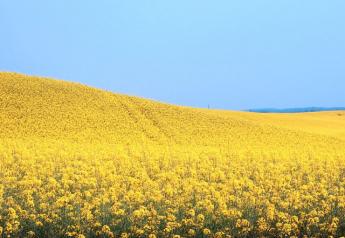The World is Now Watching U.S. Winter Wheat Harvest, Yields in Oklahoma and Texas Reveal Some Surprises
U.S. Farm Report 06/25/22 - Farm Journal Report
The start of summer also ushers in the steady rhythm of wheat harvest across the plains. What typically is picture-perfect setting of beauty from amber waves of grain is one that shows the scars of drought.
In the Texas panhandle, farmers saw not even a half of an inch of rain during the heart of the growing season. As a result, yields are poor in the fields that did survive. Scott Irlbeck, a farmer in Tulia, Texas, says dryland wheat in his area yielded 8 to 10 bu. per acre. On a good year, the fields that don’t have irrigation can yield around 20 bu. per acre.
“Considering the lack of rainfall we received since way back in the fall, I wasn't surprised with dryland yields of wheat,” Irlbeck says. “I was surprised with some of the wheat. I tried to irrigate. I thought I'd have a little bit better yields, but that wasn't the case either. I was ending up with 25 to 30 bushels an acre on irrigated, which isn't great.”
The latest USDA Crop Progress Report showed 72 percent of Texas’ wheat crop was harvested as of Sunday, June 19, which is 7 percentage points ahead of normal.
Just to the north, Oklahoma’s wheat harvest has been in full swing for several weeks, and a week ago, USDA said 72 percent of the state’s crop is harvested. Clint Wilcox farms in northwest Oklahoma, and he says the lower yields have helped speed up harvest, even with some rain events that put a pause on harvest from time-to-time this summer.
“My bushels per hour aren't a whole lot different than they were a year ago, I’m just driving two and a half times as fast,” says Wilcox.
He says so far, most of his fields have yielded over 30 bu. per acre, but he was starting to see some fields that looked a little lighter on yield.
“The one that we started last night is making in the 20s,” he says. “We’ll probably get into some that are quite a bit worse than that before it's over.”
For Wilcox, yields have also been surprising, but in a good way, as expectations were extremely low heading into harvest.
“This is not anywhere near the worst wheat crop that I’ve seen,” says Wilcox. “I think 2011 and 2018 were much worse here.”
This wheat crop he’s harvesting is still 40 percent below the strong harvest farmers in this part of Oklahoma saw last year, but it’s still not as bad as it could be.
“I'm not sure how this one pulled through as well as it did, but the few rains that we had were just timely enough. I think that somehow this crop is quite a bit better than 2011 and 2018,” he says.
Across the state, wheat harvest is also in full swing. Farmers are hustling to get the crop out after some of Oklahoma saw 11 inches of rain in May. Brian Arnall, an Oklahoma State University (OSU) extension precision nutrient management specialist, says wheat harvest is basically border to border.
“Right now, we're in central Oklahoma. We're fighting humidity, so we're not starting till mid-day,” says Arnall. “More of our western regions can run. We are getting some great nights. We've got nice wind, so our humidity is dropping down and we can run from about noon or 1 p.m. through 9 p.m. or 10 p.m.”
Arnall says the dryness early on in the growing season took a toll on overall yields.
“Harvest reports are marginal, and I’m getting some good protein numbers. People are more excited about reporting proteins than they are yields this year,” says Arnall.
He points out Oklahoma’s wheat yields are mixed across the state, but the research farms he’s harvesting are producing yields 50 to 60 percent below average.
“Where I want 70, 80 or 90 bushel [per acre], I’m cutting 40 to 50 bushel yields,” Arnall says.
Test weights are also all over the board. But the rain’s a month ago were followed by intense heat. That created some issue with tillers, and also created a fight in the fields with more weed pressure due to the recent rains.
While the battle is never-ending, farmers in Oklahoma are thankful to have a crop to harvest this year. Jimmy Kinder, who farms in southern Oklahoma, also faced with drought this year, says wheat yields are struggling as a result.
“In western Oklahoma, we're kind of short a wheat crop, so they're able to travel pretty fast across the acres where yields are anywhere from 10 to 30 bushels [per acre] so far. That's kind of what we've expected,” says Kinder.
Kinder’s wheat yields are disappointing, but he knows it could be worse. Farther west in Oklahoma, those farmers don’t have much to harvest, and some don’t even have a crop at all.
“We're just glad to be cutting because farther west of me in Altus and in those areas, it’s worse,” says Kinder. “I have nothing to complain about. It really hurts to not have a crop whenever you have a good price. We just hope for a better year for everybody next year.”
Even in areas that have a crop, other signs of the drought are also showing up in unexpected ways across Oklahoma.
“We've not seen that many custom cutters in the area this year, which is a little bit scary,” says Kinder. “Not a lot of them here as they are also having a hard time with this short wheat crop.”
Kinder says there haven’t been long lines at the elevator, either. And even with prices at the elevator nearly double what Kinder saw last year, the farm financial picture isn’t all upbeat.
“We're going to probably gross the same amount of dollars we normally do, because we're having a half a wheat crop and double the price. So we're thankful that the price has responded well,” says Kinder.







